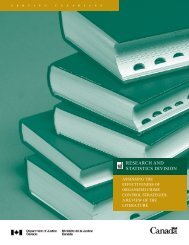National Threat Assessment 2008. Organised Crime - Politie
National Threat Assessment 2008. Organised Crime - Politie
National Threat Assessment 2008. Organised Crime - Politie
You also want an ePaper? Increase the reach of your titles
YUMPU automatically turns print PDFs into web optimized ePapers that Google loves.
esidence of groups of immigrants from these countries brings a risk of imported<br />
(organised) crime. The formation of ‘criminal bridge heads’ has already been<br />
mentioned in this regard.<br />
Attention paid by the police and the judicial authorities<br />
Property crimes are generally not assigned a high priority by the police, but<br />
the recently intensified collaboration between trade associations and the police<br />
makes it easier to control these types of crime.<br />
4.6.7 Conclusion<br />
After decreasing for several years in a row, the number of robberies increased<br />
again in 2007. There is no clear explanation for this increase. Robberies may be<br />
on the rise because it has become more difficult to carry out ram raids as a result<br />
of tougher security measures. The recently intensified collaboration between<br />
trade associations and the police and improved security around potential targets<br />
might reduce the number of robberies in the future, albeit that there is a limit<br />
to how much the security options can achieve. The retail trade – which is where<br />
the most robberies are committed – is facing a dilemma between security<br />
and accessibility.<br />
Furthermore, there is a risk of an increase in the number of robberies because of<br />
the prosperity gap combined with a increase in mobility. In the future we will<br />
therefore have to take into account at least the current scale of robberies. It<br />
speaks for itself that robberies seriously harm Dutch society, especially in the<br />
form of the non-tangible, psychological harm suffered by victims of these<br />
offences and the effect that these offences have on people in the surrounding<br />
area. In recent years, an increase in the use of physical violence during robberies<br />
has also been observed. For these reasons, ‘organised, supraregional robberies’<br />
have been qualified as a threat.<br />
The scale of ram raiding is limited. The damage is mainly financial and relatively<br />
small hauls are stolen in the ram raids. The non-tangible, psychological harm<br />
caused by ram raids is less serious than that caused by robberies, as there is<br />
generally no confrontation between offenders and victims, but it should be<br />
noted that these offences do affect people’s general feeling that they are not<br />
safe. Future developments are difficult to predict due to the fluctuating scale of<br />
these activities and the fluctuating amounts stolen in the recent past. The<br />
reduction in the scale of ram raids may continue if the aforementioned<br />
displacement effect does occur. Moreover, the consequences are generally<br />
limited. Controlling the phenomenon of ram raiding mostly comes down to<br />
prevention: promoting security measures and compliance with procedures.<br />
chapter 4 – Supraregional property crime<br />
171








